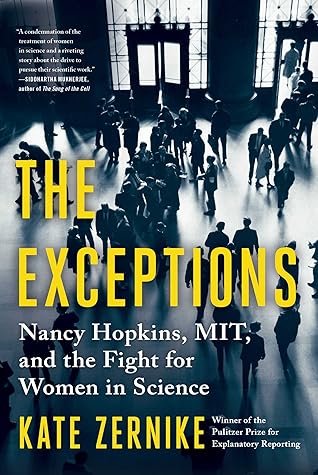More on this book
Community
Kindle Notes & Highlights
by
Kate Zernike
Read between
March 8 - March 18, 2023
A year or two after she graduated she was in the law library there and decided to look herself up in the Harvard Alumni Directory. There she found her name followed by a series of acronyms: BA, MBA, JD, W/M. Not recognizing the last one, she went to the key and discovered “wife and mother.”
I was about twelve and did not fully understand her fury as she came rushing out of the law library, where I was sitting on the steps. She drove home ranting, “W slash M! W slash M?” In time it became a family joke.
But Crick arrived so suddenly behind her in the little side lab that she realized he was there only because his hands were on her breasts.
Woman’s Experience of the Male, later translated into English and still being updated in the 1960s, was considered one of the first explicit feminist tracts. (“Only men who are sure of their sexual potency are attracted by the independent woman,” Lazarsfeld wrote in one of its less racy passages. “Indeed, it is possible to gauge the degree of a man’s potency from his attitude on the question of gainful employment for women.”)
theory of Ideal Mental Health, identifying the five necessary elements as time structure, social contact, collective purpose, social identity, and regular activity.
Her paper argued that within a certain class, women started out with more choice than men, because while men were expected to work and earn a living, women could still choose whether to do so. But once women decided to work, their choices narrowed, and they faced constraints men did not.
Anatomy was destiny: men had “an external organ, erectible and intrusive in character, serving the channelization of mobile sperm cells”; women had “internal organs,” with “vestibular access, leading to statically expectant ova.”
Crick had once said that your best friend in science is the one who is most critical of your data before you publish it,
Vera Kistiakowsky, a forty-two-year-old research associate in the physics department at MIT, started a women’s committee within the American Physical Society in April 1971, having grown weary of male colleagues saying they couldn’t hire women because there were no female physicists to hire.
It had been a hangover from the anti-communist panic of the McCarthy era, when hundreds of professors were hauled before Congress or fired by their universities under suspicion of left-wing beliefs or affiliations. Congress wanted to show that the government would no longer meddle in university employment decisions, so it exempted higher education from the Equal Pay Act of 1963 and from Title VII, which prevented job discrimination on the basis of sex, race, ethnicity, or religion.
She took up smoking, an old habit from the lab that she had quit to try to get pregnant. Unable to eat, she lost twenty-five pounds and ended up in the Harvard infirmary, where she watched, alarmed, as they took away her shoelaces. Her single scientist friends visited and offered to have sex with her, thinking she was just lonely. She thanked them for their kindness but declined. She wasn’t lonely; she missed Brooke.
She liked to remind young women that she had taken off only five days to deliver her three sons and advised her graduate students with what one thought of as Millie’s Quantum Theory of Babies: “You must have either two or four kids for a stable family life because kids are like electrons in an atomic orbital. They come with spin up and spin down, so you need to have a stable configuration. You can’t have one or three kids because that would be unstable.”
Affirmative action programs, he wrote, were necessary short-term steps. “They are predicated on what we know to have been years, decades, perhaps centuries of practice that tolerated bias, discrimination, and a treatment of people on the basis of stereotyped views and misguided convictions of what they want and what they are entitled to.” These attitudes, he warned, “will not go away by virtue of a faculty vote or the forging of guidelines.”
Millie Dresselhaus had gotten a grant from the Carnegie Foundation to continue her work helping women on campus,
“There is a widespread perception among women faculty that there is consistent, though largely unconscious, gender discrimination within the Institute,” they wrote. “We believe that unequal treatment of women who come to MIT makes it more difficult for them to succeed, causes them to be accorded less recognition when they do, and contributes so substantially to a poor quality of life that these women can actually become negative role models for younger women,”
The data hinted at how marginalization worked: men and women often started out equally, but while women struggled against a thousand cuts, men were accruing small benefits—a modest grant here, a crucial piece of equipment there. No one had necessarily intended to discriminate; it was more what the department heads had defended as the entrepreneurial culture of MIT: you could get what you wanted if you knew to ask for it. The women did not know; they took what they had been given and assumed everyone was following the same rules. Or they were too polite to ask: some men received raises to keep
...more
If science wanted to solve the world’s hardest problems, why even risk closing it off to half the world’s population? “We’re engineers,” Brown told Nancy. “We fix things.”


